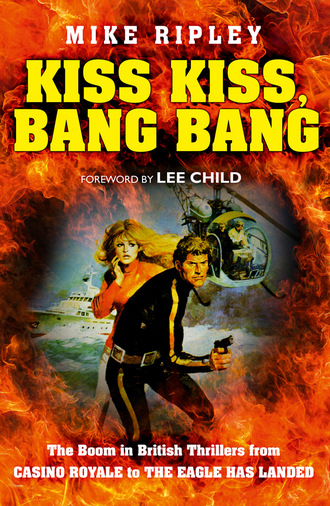
Полная версия
Kiss Kiss, Bang Bang
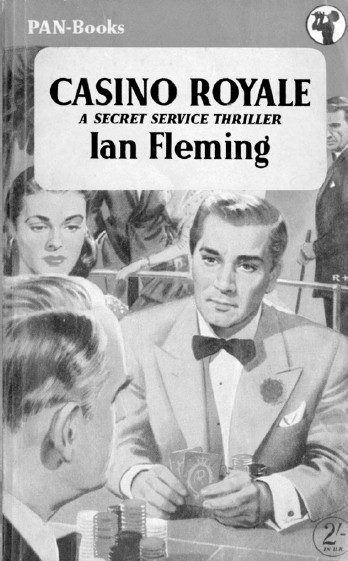
Casino Royale, Pan, 1955, illustrated by Roger Hall
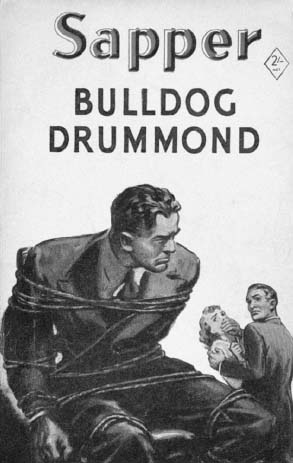
Bulldog Drummond, Hodder & Stoughton, 1920
Before Bond, heroes had been upright, square-jawed, patriotic, honourable, and always kind to women, dogs, and horses, though not necessarily in that order. If a John Buchan hero had a gun in his hand it was usually because he was striding through the heather of a Scottish grouse moor – and the same could be said of the heroes of Geoffrey Household’s thrillers of the early Fifties, substituting a Dorset heath for Scotland. Any game that James Bond was hunting with a gun was invariably human and he did not really seem to care too much if an innocent bystander got in the way, and whilst avid fans of E. Phillips Oppenheim and Peter Cheyney would feel right at home with the descriptions of luxury living and thick-eared violence, there was no doubt that Bond was something different.3
Unlike the grey and shady worlds created before the war by those masters of the more ‘realistic’ spy novel, Graham Greene and Eric Ambler (and indeed W. Somerset Maugham in his influential 1928 ‘novel of the secret service’ Ashenden – or The British Agent), Fleming had created a Technicolor dream land littered with fast cars, trips abroad, good food, fine wines, and beautiful women. It was just the sort of fantasy needed to brighten the monochrome Fifties landscape.
As John Welcome was to put it, Casino Royale had ‘put the blood and thunder (especially the blood) back into the thriller … [restoring] three essential ingredients: pace, violence and vitality.’4
Confident that he had written a successful thriller, Fleming himself indulged in a bit of fantasy. He bought a gold-plated typewriter and then requested a first print run of 10,000 copies from his publisher. The publisher, Jonathan Cape, took this request from a debut author as seriously as any publisher ever takes a request from a writer and printed half that quantity. That first run sold out in under a month and Fleming was left grinding his teeth when a second print of only 2,000 copies went equally quickly.5
However shaky, to Fleming, was the start for Casino Royale (though many a contemporary crime writer would be very pleased, in fact rather smug, with that initial hardback print run), it has been estimated that within five years, once the Pan paperback edition had appeared in 1955, a million Britons had bought Casino Royale, though fewer than one in 10,000 would ever visit a casino.6 They did not have to: the fact that James Bond was quite at home in a casino or a five-star hotel, or on a transatlantic jet-liner or a beach in Jamaica, was fantasy enough for most readers in those austere times.
There was another male fantasy which James Bond provided in satisfying quantities in comparison with what had gone before: sex. Kingsley Amis put it succinctly thus: ‘No decent girl enjoys sex – only tarts. Buchan’s heroes believed this. Fleming’s didn’t.’
It may seem that James Bond provided everything readers, at least male ones, desired that they were denied in real life: sex, travel, luxury branded goods, un-rationed foods, alcohol, sadistic villains and guns to battle them with, cars, and all with an impressive salary of £1,500 a year, as well as a small private income, as revealed in Moonraker. (Bond’s boss, ‘M’, by the time we get to On Her Majesty’s Secret Service, received a staggering £5,000 a year, almost as much as a Chancellor of the Exchequer.) Which red-blooded male would not want to be James Bond (perhaps without the famous Casino Royale carpet-beater torture scene), let alone read about him?
Yet in the overall thriller market, Bond did not have it all his own way, far from it. Fleming himself took a keen interest in how his rivals in the bookshops were doing and in 1955 undertook a piece of undercover work, wining and dining an executive from a rival publisher, Collins. He was somewhat chastened to learn that the books of the leading writer of adventure thrillers, Hammond Innes, were regularly selling between 40,000 and 60,000 copies in hardback and were already proving successful as Fontana paperbacks. They were to be even more successful in the next decade, despite the fact that they contained no sex or sadism and relatively little violence. Innes’ heroes were anything but supermen, rather they were invariably honest, decent, and upright citizens. They certainly did not have expensive tastes in wine, food, or clothes and were more likely to be found driving a bulldozer or a snow plough than a supercharged Bentley (though Hammond Innes’ books always supplied a touch of the exotic through their settings). The reader could always rely on Innes for an exciting scene or two involving skiing or sailing, usually in extreme weather conditions, and travel to a foreign land unfamiliar to most readers. The Strange Land, published in 1954, was far from one of Innes’ best adventures but it was set in Morocco, a country which today is considered a tourist destination only a three-hour-flight away but for most readers back in 1954 must have been as mysterious as Conan Doyle’s The Lost World.
There was also competition from other thriller writers who were now seasoned veterans. Dennis Wheatley, who had briefly worked with Fleming on deception initiatives during the war, was exorcising his two favourite demons in the shape of communism in Curtain of Fear and Satanism in To the Devil – A Daughter. That other stalwart of the thriller genre, Victor Canning, who like Wheatley and Innes had first been published before 1939, was also enjoying considerable success. Three of his thrillers – The Golden Salamander, Panthers’ Moon and Venetian Bird, set in Algeria, the Swiss Alps, and Venice respectively – had been filmed between 1950 and 1952, with reliable British stars such as Trevor Howard and Richard Todd. In 1953, arguably Canning’s best spy story A Forest of Eyes was published as a Pan paperback. Set in Yugoslavia, this book was clearly influenced by Eric Ambler’s 1938 thriller Cause for Alarm set in Italy (Canning and Ambler were wartime pals), which also, coincidentally, became a Pan paperback in 1954.

A Forest of Eyes, Pan, 1953
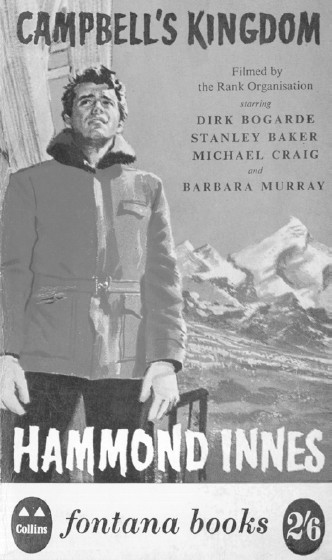
Campbell’s Kingdom, Fontana, 1956
Paperback editions were becoming an important factor in the thriller market, both in style and volume. The Pan edition of Canning’s Venetian Bird had a ‘film tie-in’ style cover (though an illustration rather than a still photograph from the film) clearly showing Richard Todd in the lead role. The later Fontana paperback of Hammond Innes’ Campbell’s Kingdom similarly referenced the 1957 film, with an illustration of star Dirk Bogarde. On the crime fiction front, Penguin had shown what could be done in terms of volume by launching an author as a ‘millions’ author, starting in 1948. Prolific crime writers such as Agatha Christie, Dorothy L. Sayers, Margery Allingham and John Dickson Carr would have ten titles issued simultaneously, each with a print run of 100,000 green-jacketed copies, making a million paperbacks per author.
Cheap paperbacks may well have ‘democratised literature’ and even, in lieu of a shrinking Empire, spread British values across the world7 but they were not the only source of popular fiction. Between 1949 and 1959, the number of books in public libraries increased from forty-two million to seventy-one million, and an estimated 70 per cent of borrowings were thought to be fiction8 which naturally gave rise to grumbling in some quarters that ‘fiction on the rates’ was not a good use of public finances. It was hardly a subversive socialist plot as much of the library expansion came under Conservative governments, perhaps to help convince voters that they had never had it so good and as more than a quarter of the British population had a library card, it was a constituency too large to ignore.
Not all libraries were in the public sector: there were commercial subscription libraries such as the Boots Booklovers Library in branches of Boots the High Street chemist. Established in 1898, the BBL attracted one million subscribers during World War II and, by 1945, Boots were buying 1.25 million books a year, but the decline set in during the Sixties with the boom in paperbacks and the Boots operation closed in 1966. A similar fate awaited the W. H. Smith Lending Library which had opened in 1860 and had specialised in crime and romantic fiction initially for railway passengers. It issued its last borrowings in 1961, though some subscription libraries attached to large department stores did continue to service loyal customers into the Nineties.9
For those thriller addicts who could not wait for the paperback of a favourite author’s latest, usually a minimum wait of at least two years in the Fifties (often three, sometimes five), a number of book clubs started up offering cheaper hardback editions to members who usually subscribed to a set number of titles per year, one of the earliest being the Thriller Book Club. These clubs were to flourish in the Sixties, often producing their own promotional catalogues and developing stylish artwork for the jackets. They attracted the biggest-selling authors of the day and continued into the 1980s.
From 1956 onwards, starting with Live and Let Die, Fleming’s Bond novels also appeared in cheaper editions published by The Book Club (established by Foyles, the bookseller), usually a year after the first hardback editions and a year before the paperback. The Bond novels also began to be serialised in national newspapers – an increasingly important promotional tool for books, as not only did more people use libraries in the Fifties, they also read more newspapers. From Russia, with Love was the first, serialised in the Daily Express in 1957 at the time the book was published (a comic strip version was to follow in 1960) and this undoubtedly helped sales.
Fleming’s publishers (Jonathan Cape) were confident enough to have produced an initial print run of 15,000 copies of From Russia, with Love and it is difficult now, knowing how famous the title became, to understand how the book could not have been the top-selling thriller of 1957. The problem was that Bond was being out-gunned and out-actioned – if not ‘out-sexed’ – by another sort of thriller. The Guns of Navarone, a rousing, wartime adventure thriller and the second novel by a newcomer called Alistair MacLean, reputedly sold 400,000 copies in its first six months.
MacLean was just one of several new thriller writers to make their mark in the decade of James Bond’s creation – along with such as Francis Clifford, Berkely Mather, John Blackburn and Desmond Cory (who does have something of a claim to having beaten Fleming to producing the first ‘licensed to kill’ secret agent). None were, in the long run, likely to seriously compete with Fleming and Bond, but for a while, MacLean certainly did. However, once Fleming’s books started to be filmed (something Fleming had been very keen on from the start – perhaps, as it turned out, too keen), Bond’s iconic status was assured of immortality.
Fantasist though he might have been, even Ian Fleming could not have seen the future and the scale of the industry his creation would become, but he did have the wit to acknowledge the man who had shaped the more realistic modern spy thriller: Eric Ambler.
As James Bond faces execution at the hands of assassin Red Grant across a compartment on the Orient Express in one of the most famous scenes in From Russia, with Love, both men have books to hand. Grant has a copy of War and Peace which is actually a cunningly-disguised pistol (Bond has given his own gun to Grant, proving perhaps that he wasn’t always the sharpest throwing-knife in the attaché case) but Bond has a copy of Eric Ambler’s The Mask of Dimitrios, into the pages of which he slips his gunmetal cigarette case. When the assassin shoots, Bond whips the armour-plated book over his heart and stops the fatal bullet.
It would be stretching a point to say that without Eric Ambler there would have been no James Bond, as Fleming took his inspiration from a more fantastical school of ‘blood and thunder’ thrillers and played up the fantasy element, rather than down. But in one way one could have said in 1957 that without Eric Ambler there would have been no more James Bond …
Chapter 3:
DO MENTION THE WAR
In his 2012 study ‘British Crime Films – Subverting the Social Order’, Barry Forshaw surveyed crime movies over the period book-ended (roughly) by the two versions of Graham Greene’s Brighton Rock in 1947 and 2010, and he put up a valiant defence of films unjustly forgotten or ignored by a generation of cinema-goers who have never seen a black-and-white film. His central thesis was that crime films acted as a prism through which British society, its attitudes and morals, could be viewed and indeed subverted by the film-makers and posed the question as to whether it was possible ‘to read a nation through its popular entertainment’.
Reviewing Barry’s book at the time I suggested that, certainly post-1945, their comedies and, in particular, their war films might provide a more accurate insight and were a far better way to ‘read’ the British.
The satires of the Boulting brothers in the mid-to-late Fifties, especially I’m All Right, Jack, took a scalpel, if not a harpoon, to the white whale that was the British class system, but the war films of that decade did not attempt to prick or cut away accepted British attitudes. In fact, they reinforced the certainties – that Britain won the Second World War, that simple British pluck could defy and defeat a tyrannical enemy, and that we were all in it together; especially when we stood alone, guardians of an empire on which the sun never set. It was only in the early Sixties, with films such as Tunes of Glory, King & Country and Guns at Batasi, that the British love affair with their armed forces began to be questioned. Significantly, none of those movies were actually set during World War II.
The effort and sacrifice of 1939–45 was such an ingrained part of the British psyche that film-makers seemed loathe to challenge it. Heroism, sense of duty, making do, carrying on and stoicism in the face of overwhelming odds were the values expected by cinema-goers of their military men (and of course their women) and these were faithfully reflected by the film-makers, be the characters on a suicide mission in a midget submarine, dropping dam-busting bombs or escaping from a POW camp.
Whether or not the war films of the Fifties can be said to be a way of ‘reading’ British society at the time is still up for debate. It was always a precept of the sociology of cinema that when times were hardest, popular cinema responded with carefree, escapist fantasies; the example always cited being the Hollywood musicals of Busby Berkeley which waved a feather boa in the face of the American Depression of the 1930s. Britain was not replaying the Great Depression in the Fifties, but austerity was the watchword (and a word somewhat diluted in strength in the far more comfortable twenty-first century) as economic recovery from the bankruptcy caused by winning the war – if not the peace – came painfully slowly. This was surely a time when British cinema could have stepped up and lightened the mood with some spectacular dance routines or a few show-stopping musical numbers. Yet British audiences seemed to prefer squads of khaki-dressed soldiers (or POWs) drilling on a parade ground and the nearest they got to a musical number was the obligatory scene in an RAF Mess featuring a sing-song around a pub piano over half-pints of flat mild ale.
If the war films of the Fifties provide an unreliable lens through which to ‘read the British’ they certainly influenced what the British read when it came to popular fiction.
Cinema admissions in Britain declined throughout the Fifties and by 1962 were roughly a quarter of their peak in the post-war year of 1946. The biggest single factor in this decline was the growth of television, with a second broadcaster, ITV, challenging the BBC’s monopoly from 1955. The number of domestic television licences grew from around two million in 1953 – the year when an estimated television audience of twenty million viewed the Coronation of Queen Elizabeth, presumably ten people watching each set – to over ten million licences by the end of 1959.1
The growth of television, a medium always hungry for product, may have torpedoed cinema-going but it provided a life-raft for British war films in the form of a new audience – teenage boys obsessed with all things militaria and who, after 1960, no longer had the opportunity to vent their excess adolescent energy in National Service.
War films became regular fare on television, particularly in the BBC’s Sunday ‘Film Matinee’ slot, and British studios and producers had ensured there was a healthy back catalogue of stories of derring-do featuring familiar faces (John Mills, Richard Attenborough and Jack Hawkins were rarely seen out of uniform) and they, almost invariably, guaranteed a British victory.
Taking the period between the first Bond book (Casino Royale) in 1953 and the first Bond film (Dr. No) in 1962, the British film industry refought the Second World War on land, in the air and on – and under – the sea and a surprising number of these films still surface on British television in the twenty-first century, some of them quite regularly The Cruel Sea, Malta Story, The Red Beret, Albert R.N., Appointment in London, The Dam Busters, The Cockleshell Heroes, Above Us the Waves, The Colditz Story, Battle of the River Plate, Reach for the Sky, The Man Who Never Was, A Town Like Alice, The Bridge on the River Kwai, Ill Met by Moonlight, Yangtse Incident (not actually WWII but close enough), Battle of the V-1, Carve Her Name with Pride, Dunkirk, I Was Monty’s Double, Ice Cold in Alex, Sea of Sand, The Silent Enemy, Danger Within, The Long and the Short and the Tall, The Guns of Navarone, The Password is Courage. With only a few exceptions, where big American stars were parachuted into productions to secure funding or transatlantic release such as Alan Ladd in The Red Beret, William Holden in The Bridge on the River Kwai, and Gregory Peck in The Guns of Navarone, these were very British films (in spirit if not finance) celebrating British pluck, decency, and the fine art of keeping the upper lip stiff. They depicted heroes; British heroes, who could easily be distinguished from American film heroes, as British heroes won their medals by following orders however futile the outcome seemed, whereas gung-ho Americans tended to admire individual initiative and allowed their heroes to take matters into their own hands, disobeying stupid orders to grab the victory.
Throughout the Fifties the British were washed with a steady stream of wartime imagery and military life and even two of the hit film comedies of 1958, Norman Wisdom’s The Square Peg and Carry On Sergeant (the first in the long-running – some would say interminable – series which would become a British institution) had WWII/National Service settings. Yet it was not only in the cinema. The war permeated the bookshops and libraries, two of the bestselling authors of non-fiction being Paul Brickhill and Lord Russell of Liverpool. Brickhill, an Australian fighter pilot and POW in Germany, became an international bestseller (and a fixture on most teenage boys’ bookshelves) with his retelling of true wartime exploits of the Royal Air Force. His books The Great Escape (1950), The Dam Busters (1951) which was the first Pan paperback to sell a million copies, and Reach for The Sky (1954), about the fighter ace Douglas Bader who had lost his legs in a pre-war flying accident, were said to have sold more than 5 million copies, been translated into seventeen languages and all were eventually made into very successful films. Lord Russell of Liverpool, a lawyer and a prosecutor of Nazi war criminals, was inspired and appalled by his legal duties and produced a controversial bestseller in 1954 in Scourge of the Swastika. This history of Nazi war crimes shocked and awed a huge readership, whilst attracting criticism for being sensationalist. Seemingly undeterred, Lord Russell followed up his success with The Knights of Bushido, dealing with Japanese war crimes and atrocities in the Far East, in 1958.2
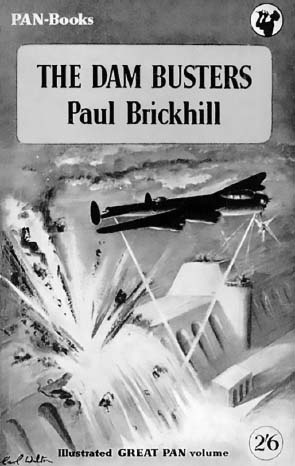
The Dam Busters, Pan, 1954
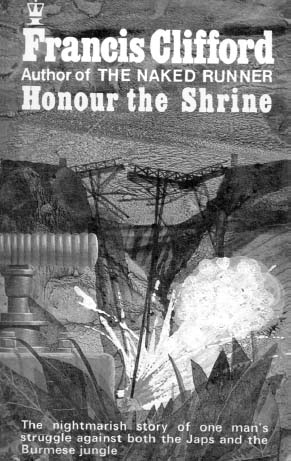
Honour the Shrine, Coronet, 1968
Conditions in Japanese prison camps had already been chillingly documented in Russell Braddon’s The Naked Island, published with drawings by Braddon’s fellow POW Ronald Searle (famous for his illustrations of St Trinian’s and the Molesworth books). The book’s original publication date in February 1952 was overshadowed by the death of King George VI and the initial print run cut to 3,000 copies. Despite few reviews and little publicity, the reputation of the book spread and by the summer of 1952, thanks to rapid reprinting, it had sold 100,000 copies. It was published as a Pan paperback in 1955 with a cover that became iconic – a defiant prisoner giving Churchill’s ‘V-for-Victory’ sign to a threatening Japanese bayonet (a variation of that cover still being used in the 1980s) – and went on to sell more than a million copies. Pan Books had another success on their hands with the epic escape story You’ll Die in Singapore by Charles McCormac (reprinted by Pan Australia as recently as 2009).
The biggest (in more ways than one) non-fiction blockbuster came in 1960 with American journalist William Shirer’s The Rise and Fall of the Third Reich, the bestselling 1,200-page popular history title, and a positive text book for would-be thriller writers. If anything, it was to cause an even bigger sensation when it appeared in the UK as a paperback on 8 May 1964 at the unprecedented price of twelve shillings and sixpence (12/6).3
Therefore, it should be hardly surprising that in this climate, many a fledgling thriller writer would, either instinctively or at the behest of an editor or agent, make their debuts with a war story. The ultimate exemplar of this syndrome is Alistair MacLean, whose first novel HMS Ulysses (based on his personal wartime experience) set in the fierce and frozen battleground of the Arctic convoys to Russia launched his international career in 1955 when it became the first novel to sell 250,000 copies in hardback within six months of publication.
MacLean was to draw on his naval service during WWII for background to his next two novels, The Guns of Navarone (1957) and South by Java Head (1958), but whereas Ulysses was a war story, and indeed a thrilling one, Navarone and Java Head were thrillers with a wartime setting. They both had casts of soldiers or sailors (plus a few suspicious civilians) and there was a war going on, the setting being a clearly identified theatre of WWII – the Aegean Sea and the immediate aftermath of the fall of Singapore in 1942. But the plots contained something more than straightforward military actions – they were there, but there was something else going on beneath the surface. Is there a traitor among the central, usually small, group of characters? Is the ‘mission’ or ‘objective’ the real agenda of the plot? Will our heroes survive against the elements (the sea, mountains, storms, etc.) as well as the official enemy (the Germans and the Japanese) and the enemy within?



